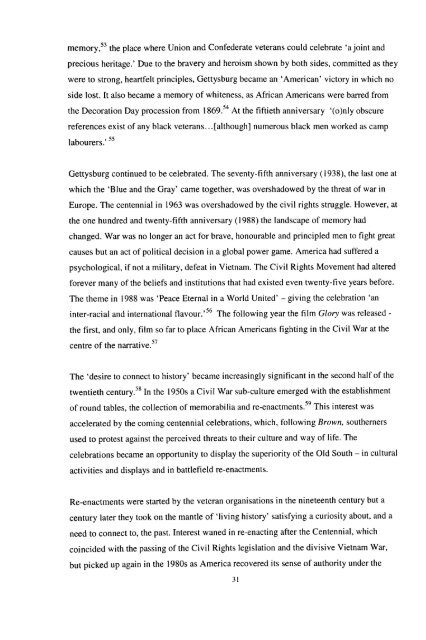Download (3483kB) - Greenwich Academic Literature Archive ...
Download (3483kB) - Greenwich Academic Literature Archive ...
Download (3483kB) - Greenwich Academic Literature Archive ...
- No tags were found...
You also want an ePaper? Increase the reach of your titles
YUMPU automatically turns print PDFs into web optimized ePapers that Google loves.
memory,53 the place where Union and Confederate veterans could celebrate 'a joint andprecious heritage.' Due to the bravery and heroism shown by both sides, committed as theywere to strong, heartfelt principles, Gettysburg became an 'American' victory in which noside lost. It also became a memory of whiteness, as African Americans were barred fromthe Decoration Day procession from 1869.54 At the fiftieth anniversary '(o)nly obscurereferences exist of any black veterans.. .[although] numerous black men worked as camplabourers. 155Gettysburg continued to be celebrated. The seventy-fifth anniversary (1938), the last one atwhich the 'Blue and the Gray' came together, was overshadowed by the threat of war inEurope. The centennial in 1963 was overshadowed by the civil rights struggle. However, atthe one hundred and twenty-fifth anniversary (1988) the landscape of memory hadchanged. War was no longer an act for brave, honourable and principled men to fight greatcauses but an act of political decision in a global power game. America had suffered apsychological, if not a military, defeat in Vietnam. The Civil Rights Movement had alteredforever many of the beliefs and institutions that had existed even twenty-five years before.The theme in 1988 was 'Peace Eternal in a World United' - giving the celebration 'aninter-racial and international flavour.' 56 The following year the film Glory was released -the first, and only, film so far to place African Americans fighting in the Civil War at thecentre of the narrative. 57The 'desire to connect to history' became increasingly significant in the second half of thetwentieth century. 58 In the 1950s a Civil War sub-culture emerged with the establishmentof round tables, the collection of memorabilia and re-enactments. 59 This interest wasaccelerated by the coming centennial celebrations, which, following Brown, southernersused to protest against the perceived threats to their culture and way of life. Thecelebrations became an opportunity to display the superiority of the Old South - in culturalactivities and displays and in battlefield re-enactments.Re-enactments were started by the veteran organisations in the nineteenth century but acentury later they took on the mantle of 'living history' satisfying a curiosity about, and aneed to connect to, the past. Interest waned in re-enacting after the Centennial, whichcoincided with the passing of the Civil Rights legislation and the divisive Vietnam War,but picked up again in the 1980s as America recovered its sense of authority under the31
















